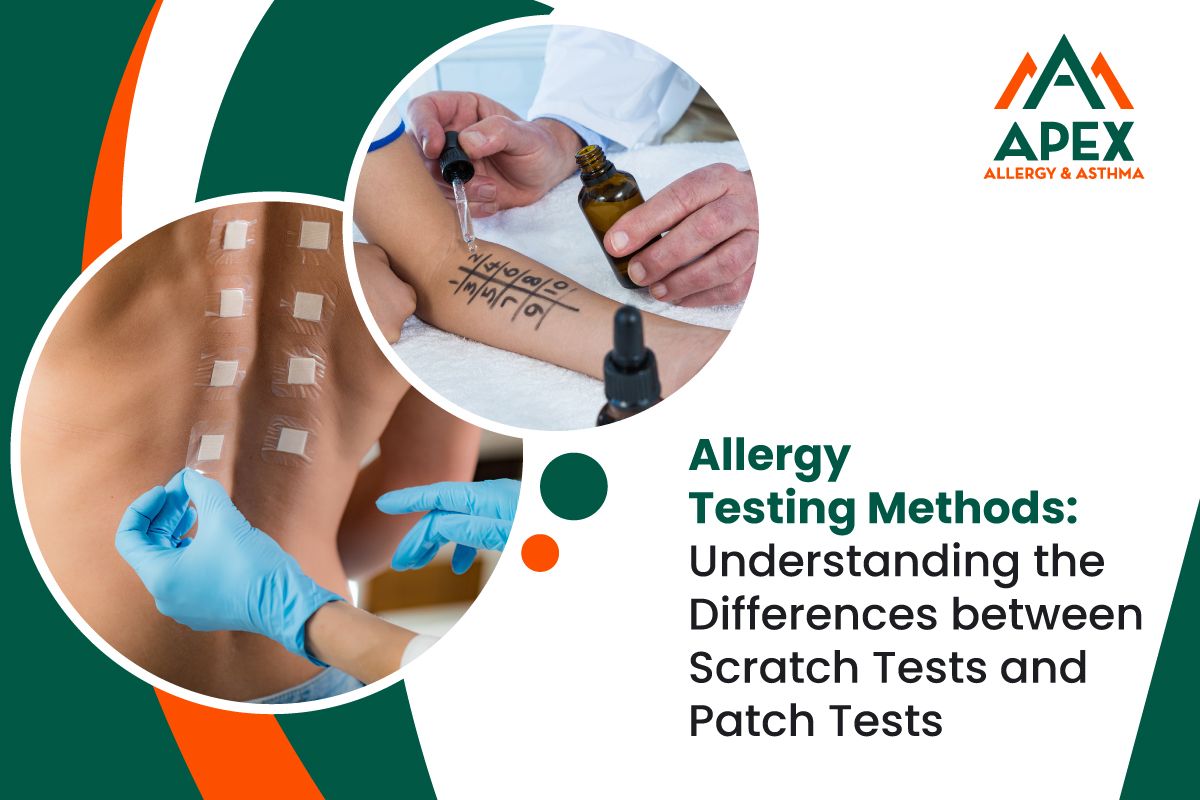A
study reveals that allergic rhinitis affects over 50 million Americans. In contrast, asthma, often with an allergic component, impacts around 20 to 30 million individuals. As allergies become more prevalent in urbanized communities, the demand for allergy testing recommendations is rising.
This article will teach you about different allergy testing methods, focusing on two primary techniques – skin scratch and patch tests. Understanding the differences between these testing methods can be crucial in identifying triggers and developing effective strategies for overcoming and managing food allergies.
Whether you're a parent concerned about your child's allergies or an individual seeking to prevent or manage allergic reactions, this guide will empower you with the knowledge you need to take control of your allergies and lead a healthier lifestyle.
Scratch Tests vs. Patch Tests
Allergy testing is a fundamental diagnostic tool that helps identify the substances triggering allergic reactions in an individual, enabling the development of appropriate treatment and effective allergy management plans. Various allergy testing methods are available, the two most common being scratch and patch tests, which are both skin allergy testing.
Scratch Tests
Skin prick/puncture testing (SPT) is a well-recognized, secure, reliable, simple, and cost-efficient method for identifying allergen-specific immunoglobulin E (IgE) antibodies. IgE is a crucial immune system component that triggers allergic reactions when exposed to specific allergens, such as germs, viruses, and other allergenic substances.
The allergy scratch test involves pricking or scratching the skin with a small amount of allergen extract to introduce the allergen into the skin. A small raised bump or redness will develop at the test site if you are allergic to the specific allergen. This reaction occurs because IgE, an antibody that our immune system produces in response to allergens, is triggered by the presence of the allergen.
- Pros:
- Provides immediate results
- Can test for a wide range of allergens
- The skin prick testing for allergies is quick and easy to administer.
- Cons:
- Can cause mild discomfort or pain during the test
- Like before any allergy testing, certain drugs, such as antihistamines, nasal sprays, and cough and flu medicines,
should be stopped.
Patch Tests
In a patch test for allergies, healthcare providers apply allergens to adhesive patches, usually placed on the back, instead of pricking the skin. The patches remain in place for 48 hours, allowing allergens to penetrate the skin. After removal, healthcare providers examine the skin for any signs of inflammation or reaction, determining the individual's allergic hypersensitivity toward the compounds used in the test.
- Pros:
- Non-invasive and painless during application
- Suitable for diagnosing delayed allergic reactions
- Can test for specific allergens related to skin irritants or contact dermatitis
- Cons:
- Side effects are itching and irritation
- Only applicable to certain types of allergies
- Requires
more time for results than scratch tests
Other Types of Allergy Testing
Apart from the scratch and patch tests, healthcare professionals may use other allergy testing methods to identify what allergens trigger an allergic reaction in patients. These include
- Intradermal Test: This is similar to the skin prick test. You inject the allergen extract under the skin's surface.
- Blood Test (Allergy Panel): An
allergy blood test or specific IgE test measures the presence of specific IgE antibodies in the blood against various allergens.
- Elimination Diet: Your doctor will suggest you remove suspected allergens from your diet and gradually reintroduce them to identify triggers.
- Provocation Testing:
Provocative testing
involves exposing people to a small amount of the suspected allergen. For instance, if doctors suspect an exercise-induced allergy, they can ask the person to exercise, or if they suspect an allergy triggered by a cold, they will place an ice cube on the skin to see if a rash develops.
Each of these allergy testing methods has advantages and limitations, and the choice of which way to use depends on the patient's age, medical history, symptoms, and the suspected allergens. To ensure an allergy test method is appropriate, consult a
qualified allergist.
The Importance of Allergy Testing
Allergy testing is crucial in identifying specific allergens that trigger adverse reactions in individuals. Understanding these triggers is essential for several reasons:
- Personalized Treatment: Identifying specific allergens allows healthcare providers to create
customized patient treatment plans. This may include avoidance strategies, medications, or immunotherapy (allergy shots) to desensitize the immune system.
- Accurately prevent triggers:
Allergy testing is essential in confirming or ruling out allergies, which helps
identify specific allergens that trigger allergic reactions. By pinpointing the exact allergens responsible for the allergies, individuals can take targeted measures to avoid exposure, leading to a reduction in harmful effects and the need for unnecessary avoidance measures and medications. This precise information allows for more effective allergy management, improving the overall quality of life for those with allergies.
- Improved Quality of Life:
By managing allergies effectively, individuals can experience significant improvements in their quality of life. Reduced symptoms and fewer disruptions in daily activities contribute to overall well-being and a sense of control over their health.
In conclusion, allergy testing is vital in identifying allergens, diagnosing allergies accurately, and formulating personalized treatment plans. It empowers individuals to take control of their allergies, manage symptoms effectively, and lead healthier and more fulfilling lives.
Frequently Asked Questions (FAQ) on Allergy Testing Methods
Are prick tests accurate in elderly individuals?
Answer: Due to age-related changes in skin sensitivity, prick tests can't be as accurate in older adults. As people age, their skin could become less sensitive, leading to reduced reactions during prick testing. This
could result in false-negative or inconclusive results, where the test can not detect an allergic response that exists.
Healthcare providers must consider this potential limitation when interpreting prick test results in elderly patients. In such cases, additional testing methods, such as blood or patch tests, could complement the prick test and ensure a more accurate diagnosis of allergies in older patients.
Is the skin scratch test safe for children?
Answer: Yes, the skin scratch test, also known as skin prick testing, is generally considered safe for children. It is a widely used and well-established diagnostic tool for identifying allergens in pediatric patients. The procedure involves placing a small amount of allergen extract on the child's skin and then pricking or scratching the surface to allow the allergen to enter the skin. Moreover, the risk of severe allergic reactions, such as anaphylaxis, from the scratch test is infrequent.
Are allergy skin testing methods accurate?
Answer: The skin testing method is typically regarded as the
most precise. Nevertheless, there are instances where skin tests could yield inaccurate outcomes, mainly if the patient has consumed any allergy medicine within a week before the test. It is essential to have qualified allergists or dermatologists perform these tests to ensure accurate diagnoses and appropriate treatment plans.
What types of diagnostic testing are appropriate to identify food allergies?
Answer: The food allergy tests that allergists commonly conduct
include:
- Blood tests
- Skin prick tests
- The oral food challenge, or the elimination diet
Check out our previous blog post, "Here's How Food Allergies Are Diagnosed," to learn more about food allergy diagnosis.
Learn the Difference Between Scratch and Patch Tests with Expert Advice
We delved into allergy testing, exploring the key differences between two standard methods: scratch and patch tests. Understanding the distinctions of these testing techniques with the help of experienced doctors can empower you to make informed decisions about your allergy management and find the most suitable approach for your needs.
Are you prepared to take charge of your allergies and obtain valuable insight into your triggers? If you’re looking for an "allergy testing clinic in San Antonio, Texas," look no further than Apex Allergy and Asthma. Our double board-certified allergist Mark Stahl, DO, and the team has extensive experience diagnosing allergies and asthma in adults and children. Please schedule an appointment today. Your journey toward a healthier, allergy-free lifestyle begins now!
You can reserve an appointment online by clicking
''Schedule Today" on our homepage or by calling (210) 490-2051.






